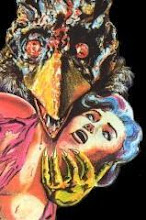 Alice in Wonderland, written in 1865 by Lewis Carroll, is the book that has inspired countless adaptations, animated or otherwise. I love Victorian era Brit Lit. The vocabulary is far too advanced for today's youth in some instances, but that is indicative of the higher educational standards of Victorian Britain (but this isn't a history lesson). The antique illustrations are a treat.
Alice in Wonderland, written in 1865 by Lewis Carroll, is the book that has inspired countless adaptations, animated or otherwise. I love Victorian era Brit Lit. The vocabulary is far too advanced for today's youth in some instances, but that is indicative of the higher educational standards of Victorian Britain (but this isn't a history lesson). The antique illustrations are a treat. The book itself is rather short, and a breezy read. It's not perfect, and I prefer the movie. I'm not saying it's awful. The book is more of a series of vaguely connected vignettes of Alice's adventures down the rabbit hole. Alice herself makes a lot of social gaffes, by saying things that are easily misinterpreted, or speaking without tact. But that's like how children are. The animals are argumentative and more animal like than their motion picture versions. I liked the playing card soldiers in the Red Queen's court better in the movie, it would have been interesting to see actual playing cards (like in the book) doing the parts in the movie. The tone was surprisingly irritated, because Alice is easily bothered by the animal's bizarreness and stupidity, and the animals are annoyed of what Alice says and her misunderstanding.
I'm going to read Through the Looking Glass next. I recommend that people see the movie first, then read the book, because it's a treat seeing memorable lines on the page. I can tell Tim Burton interpolated parts from both books into his film, and adapted some characters, and developed others further. The Mock Turtle is hilarious, but somewhat pointless to the overall narrative, but his inclusion in the movie would have been a humorous part.
The ending shows that Alice was actually dreaming (it was a languid summer day) but sweetly relates the theme of the movie: that the magic of childhood is lost on many people, but interacting with Wonderland and children can inspire it once again.





No comments:
Post a Comment